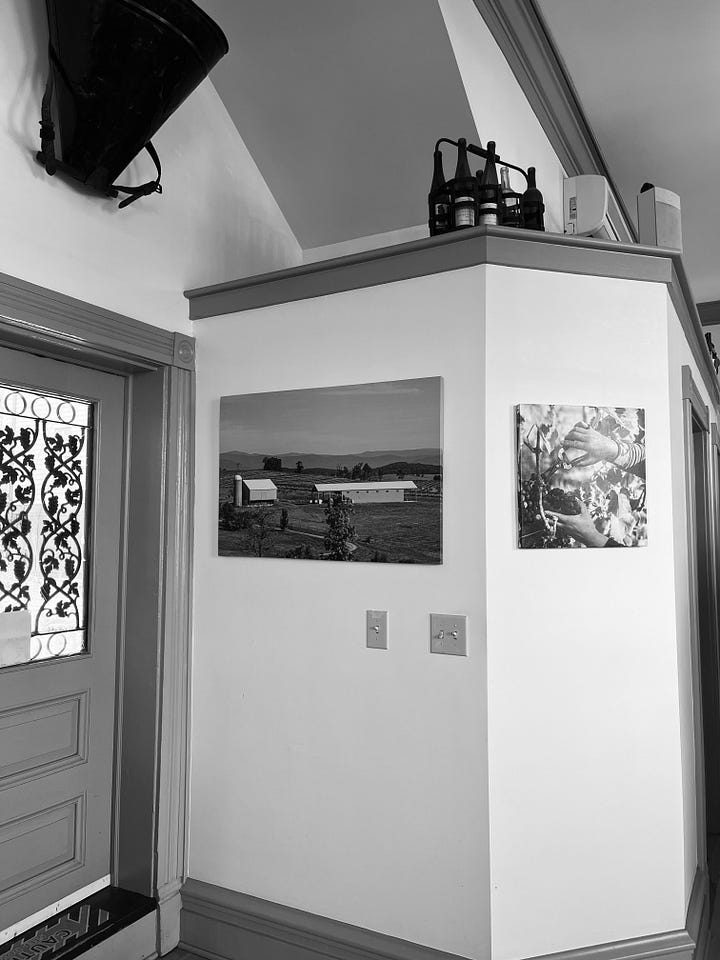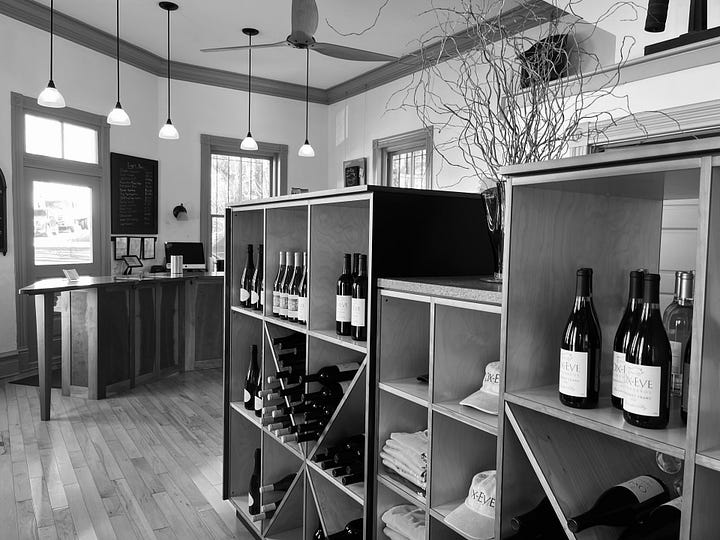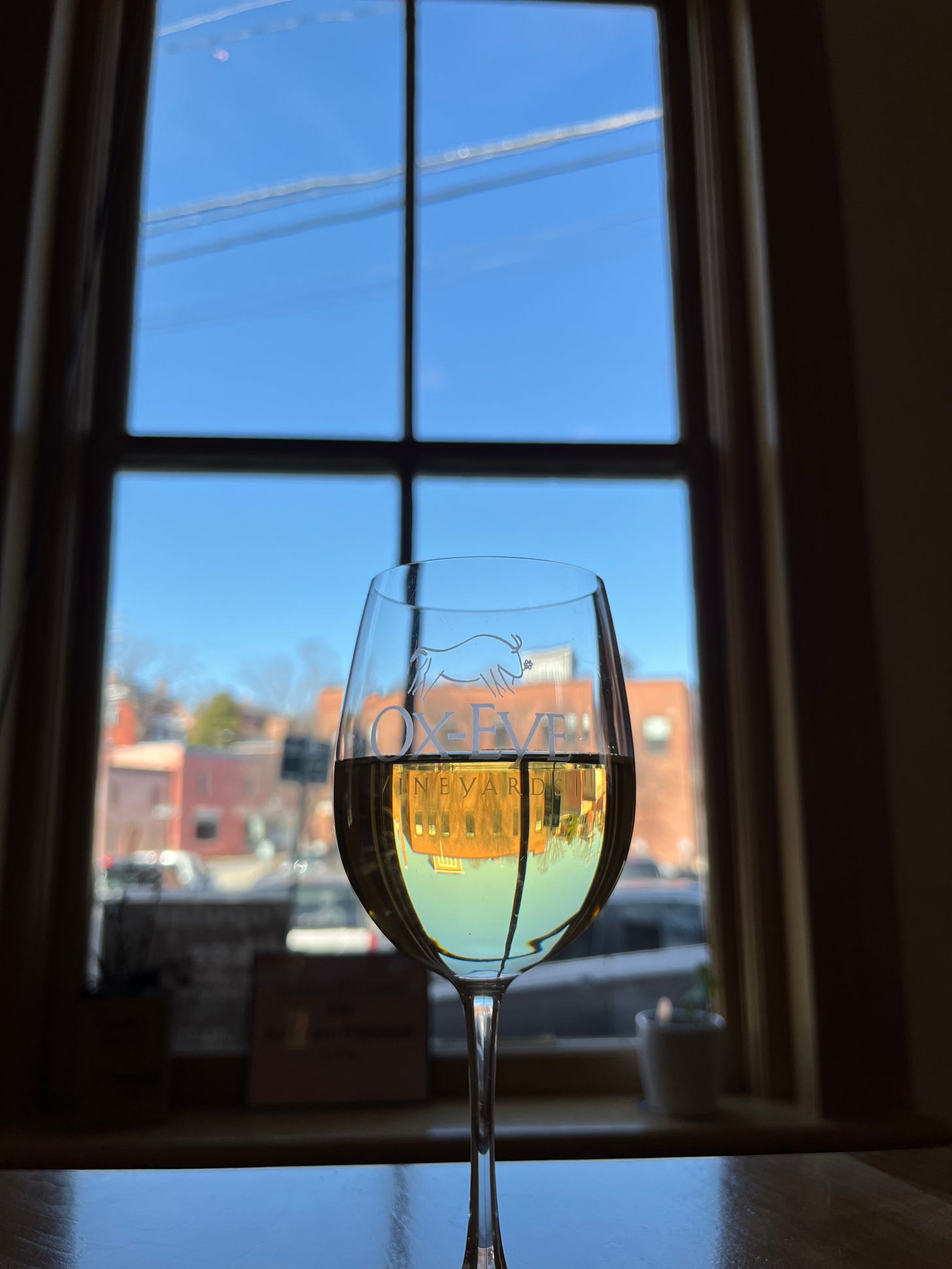A Taste of Cool Climate Wines in the Shenandoah Valley
A happy accident for the Kiers family opened the door to some of Virginia's most unique wines
We all have a moment that opens up our passion to the world of wine. For me, it was the discovery of good wines, Virginia wine in particular, when I began working as a tasting room associate at Ox-Eye Vineyards in 2015.
I was familiar with wine already and knew I liked drier wines with slight fruit-forward notes, but going through an introductory tasting with co-owner Susan Kiers opened up an appreciation I’d never realized before. These wines didn’t taste like wine - I discovered notes of apricot on the Traminette, a flinty finish on the Riesling and astonishing notes of black pepper and plum on the Lemberger. It was love at first sip.
Having said that, I consider my link to Ox-Eye to reach back more than a decade earlier, to when the Kiers’ daughters and I would run over the ridges of their family farm in the Swoope countryside where vines of Chardonnay, Pinot Noir, and many more varietals are planted today. The connection to the land and to the wines holds Ox-Eye in a special place in my heart, and returning to the beautiful tasting room in downtown Staunton always feels like coming home.

The location of the Kiers’ farm has always seemed so idyllic to me, and I was surprised when sitting down to chat with Susan Kiers a few weeks ago to learn that its particular location wasn’t their first choice when hunting for a property that would support her and husband John’s dream of growing grapes.
“We were looking in Albemarle, Nelson and Madison Counties and the sites were seeing at that time might have had a beautiful house on it but the property just wasn’t suited for grape growing,” Kiers told me. “We were looking for 20 acres altogether and we were just going to grow wine grapes for other wineries. So John was looking at soil surveys and climate charts, and he was noticing that the Shenandoah Valley was significantly drier than the rest of Virginia.
“So John started thinking we ought to look in the valley and we saw a property around Stuarts Draft or Mint Springs for sale, we contacted the realtor and met him at the property only to find out it had just been sold. He asked ‘what are you looking for?’ and John brought out the big soil survey and showed it to him. He pointed at a slope and said ‘I want something along this slope’ and immediately the realtor said ‘I have a place to show you’ and it was our farm. It’s over 100 acres which was not what we were after - we thought it was way too big - but it just felt so right. It felt so right. And as we were leaving, I told John ‘this is the farm!’”
Although the property immediately captured the Kiers’ hearts, turning it into a farm suitable for growing grapes was another challenge.
“We put everything into it - it was more farm than we were planning on - but we put everything into it. That was 1996. There were cows were roaming on it, the farm was being leased. There was sheet metal and barbed wire coils all over littering the place - I don’t know how the cows were walking on it! There was multiflora rose and little cedars growing all over it, and we got a dumpster and filled that thing with garbage. And then John got each of us a little hatchet - me, John, and the two oldest girls - and we walked up and down the hill chopping every single cedar, seedling, multiflora rose, everything that we came to. That took a long time and it took a few years - we didn’t have the big equipment then. I remember John’s first tractor - an old Massey Furguson - which got the job done. We started setting up the vineyard in 1998; at that time we put in Chardonnay and Cabernet Franc.”


What strikes me every time I taste Ox-Eye’s menu is its stark departure from your typical Virginia vineyard offerings. Instead of typical Viogner and Bordeaux-style Meritage blends, Ox-Eye’s menu showcases Riesling, Grüner Veltliner, Pinot Noir, and Lemberger. Even their Chardonnay, which thrives across Virginia, tastes more akin to a Dolomiti or Austrian wine with high acidity and crisp notes of lemon zest.
“Chardonnay and Cabernet Franc were the two grapes we started growing, and the Chardonnay has always done especially well on the site,” Kiers says. “We tend to have a little more acidity because of diurnal shift, the hot days followed by cool nights, so our Chardonnay tends to have a little lemoniness at times. Chardonnay was one of those barometer grapes, we planted it, we saw how it did, and it led us to think we could go with some cooler climate grapes.
“When we planted Riesling, that was huge. That was a grape that Virginia was highly recommending against planting because it wasn’t thought it could ripen here in Virginia, but Riesling has been such a spectacular grape for us. It’s our largest crop, it’s a crop that’s always in demand from other wineries because most of Virginia really isn’t suited for cool climate grapes. As a winery, one thing we always want to stress in the tasting room is they are local grapes. All of our wines are estate, it comes from one hillside. The weather, the rainfall, what’s in the soil, all affects what you taste in the glass.”
As the vineyard began to grow and the Kiers began to sell their fruit to local winemakers, the Ox-Eye grapes - named for the ox-eye daisy that grows around the farm - began to make a reputation in the Virginia wine industry. “We knew that we were growing quality fruit when we suddenly started getting demand and had to turn people away. There was one winemaker, Brad McCarthy, we were primarily selling to - he helped start Blenheim Vineyards and he really liked John’s fruit. Brad put the name ‘Ox-Eye’ on the Blenheim label for the Chardonnay and the Cabernet Franc, and he won an award for the Ox-Eye Chardonnay and he gave us the medal.
“Once your vineyard gets to about 20 acres or so you can’t help but think about having your own vineyard. The returns on the investment were so great at that point and we had a buffer against a bad year. John had less confidence in producing the wine than growing the wine, but by that point we had met so many talented winemakers and we had seen what they had done. And Brad said ‘John, you build a winery and I will walk you through your first pressing’. We’ve never had a consultant, but Brad is the closest we had - we’ve always trusted him.”
The Kiers built the winery on their farm and released their first red wine in 2009 and their first white in 2010. “We built it not as a showpiece but as a good, working winery - easy design, it couldn’t be more simple to work in that winery, but it's not a showcase, it’s not a beautiful Tuscan design. And we didn’t really want that because we wanted our workspace separated from the tasting room. We wanted to not worry about what things always looked like, and we live on the farm - we didn’t want people coming on the farm where we live and where we’re raising our kids. So we decided we wanted it offsite.”
The Kiers turned their sights to a historic building in Staunton’s wharf region. Once a scale house for loading grain onto the rail cars, it had been disused for years. “We knew the owner and it had been empty since the ‘80s. And it needed A LOT of work. But it had this charm: the arches, the cute little size, it just spoke to us - as it did to many other people we realized as soon as we bought it!” Today, two of Ox-Eye’s wines bear the name of Scale House in honor of the tasting room’s origins.


From its inception, Ox-Eye Vineyards has its roots in family, and today the Kiers’ third oldest daughter Harriet is following in her parents’ footsteps as co-owner of Ox-Eye Vineyards. “All the girls were part of the vineyard from the beginning - we all planted vines, we all harvested, we did every job,” Susan Kiers told me. “Harriet was the only one who wanted to be part of it forever.”
Following her graduation from the University of Virginia with a degree in chemistry, Harriet began an apprenticeship at a Champagne House in Aube. “Harriet was there for about a year and her French was not good, and their English was minimal so everything was in French. I don’t think she realized how much she learned until she came back, but she worked in every aspect of the house - she worked in the vineyards, she worked in the winery, and they explained things to her - they really treated her as an apprentice. It was lucky she got that experience because it’s very rare for an American to work at a French Champagne house. They were great to her and she is still in communication with that family.”
Following her apprenticeship in Champagne, Harriet spent additional apprenticeships in Oregon and the Finger Lakes before coming back to Ox-Eye and directing the process of their Blanc de Blancs. “She is making the sparkling wine; as far as the sparkling wine is concerned, John is more Harriet’s helper. They make decisions together, but it’s really Harriet making the sparkling wine. ‘Fizz Master’ is what we call her!”
It’s easy to imagine winemaking as a luxurious process, but witnessing the Kiers’ journey firsthand is proof that growing grapes and making wines isn’t for the weak of heart. “It’s been labor, it’s been a labor of love, it’s been a lot of work,” Kiers says. “We weren’t in a place with deep pockets. We just took one step at a time and toiled through.”
And should you ever have the chance to visit the Kiers’ farm (currently a privilege reserved for wine club members and friends of the family), a beautiful reminder to the hard work that brought Ox-Eye to fruition greets visitors the moment they set foot on the property. “We have on our gate going into the farm Labor Omnia Vincit: Work conquers all.”




